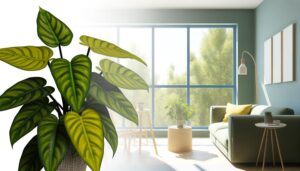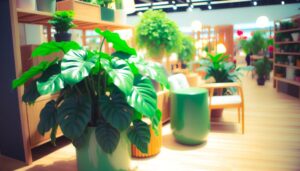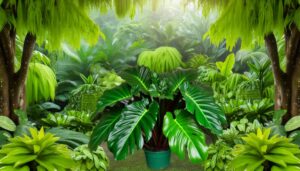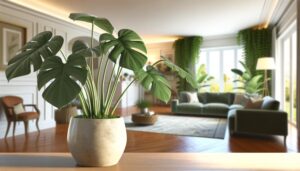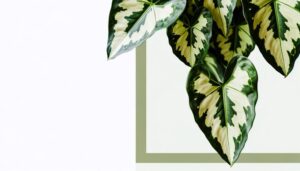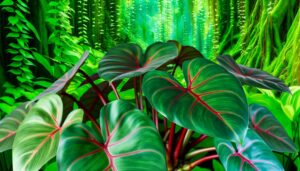What Are the Characteristics of Philodendron Erubescens 'Ruby'?
Philodendron Erubescens 'Ruby' features ovate to heart-shaped leaves, measuring up to 30 cm in length and 20 cm in width, with a glossy texture and prominent venation. The foliage exhibits a spectrum of colors from dark green to vibrant ruby red, particularly intense on the abaxial surface.
The stems, ranging from 1.5 to 2 cm in diameter, display ruby-red hues dependent on anthocyanin concentration and light exposure. Its climbing growth habit, supported by aerial roots, is optimized for bright, indirect light levels of 10,000 to 20,000 lux.
Further details on its watering needs, soil preferences, and common pests await those interested.
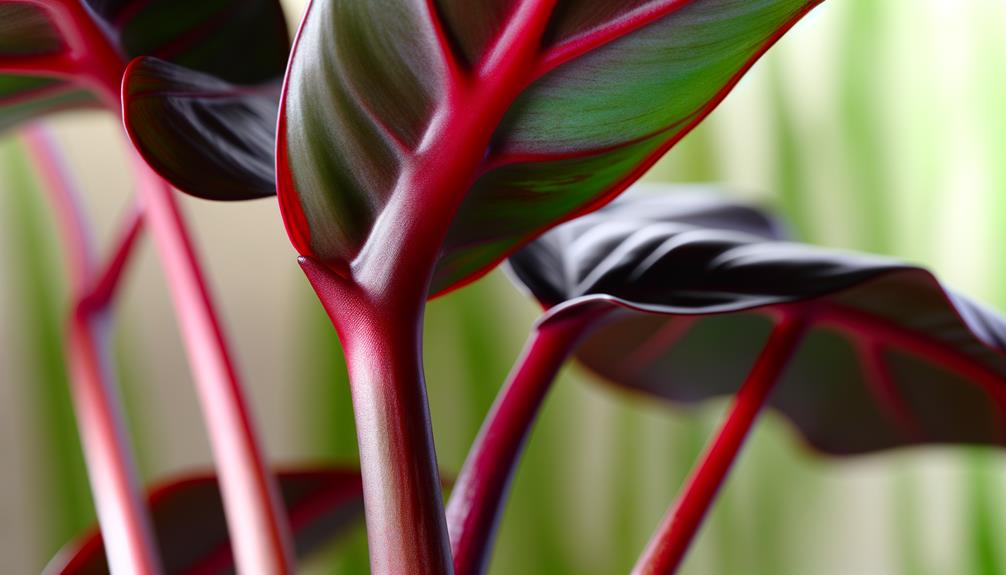
Key Takeaways
- Leaves are ovate to heart-shaped, dark green to vivid ruby red, and up to 30 cm long.
- Stems and new growth exhibit ruby-red hues influenced by light and anthocyanin concentrations.
- Prefers bright, indirect light of 10,000 to 20,000 lux and avoids direct sunlight.
- Thrives in humid conditions with temperatures between 65°F to 80°F and well-draining, organic-rich soil.
- Susceptible to spider mites, aphids, root rot, and mealybugs, requiring regular monitoring and care.
Origin and Background
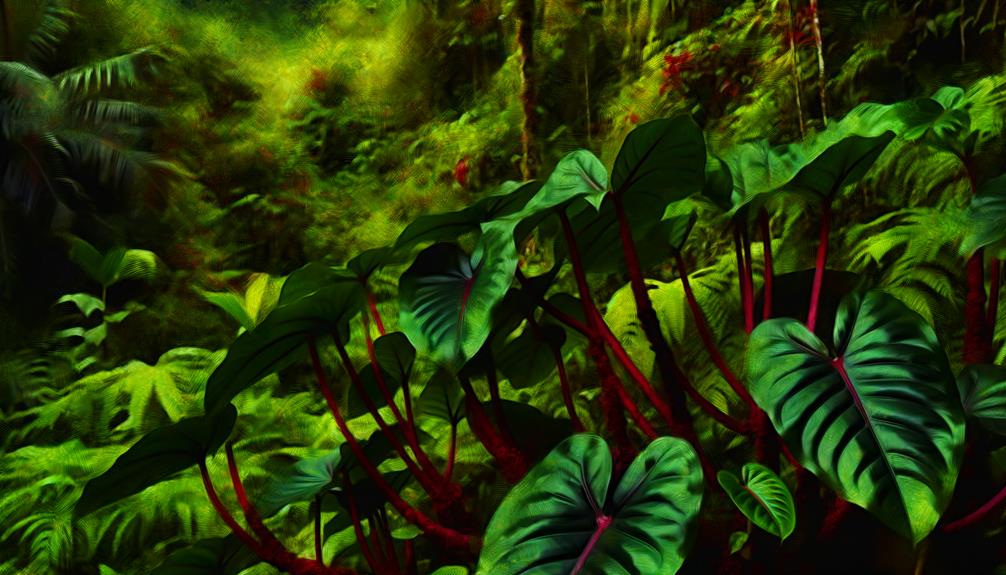
Philodendron Erubescens 'Ruby,' a cultivar of the species Philodendron erubescens, originates from the tropical rainforests of Colombia.
This cultivar thrives in humid, lowland tropical environments characterized by consistent temperatures ranging from 18°C to 25°C. The natural habitat encompasses areas with high humidity levels, approximately 70-90%, and indirect sunlight filtered through the dense forest canopy.
Philodendron erubescens is a hemiepiphyte, establishing itself initially on the forest floor before ascending trees to access more light. The substrate is typically rich in organic matter, facilitating nutrient uptake.
This species' ecological niche allows it to adapt to indoor cultivation under controlled conditions, making it a popular choice for ornamental horticulture. Understanding its origin aids in replicating ideal growth conditions for best plant health.
Leaf Shape and Size
To further comprehend the ideal conditions for cultivating Philodendron Erubescens 'Ruby,' it is essential to examine the specific characteristics of its leaves, which display an ovate to heart-shaped morphology and can reach up to 30 centimeters in length and 20 centimeters in width. These leaves are distinguished by their prominent venation and smooth, glossy texture, which helps maximize photosynthetic efficiency.
| Measurement | Value |
|---|---|
| Maximum Length | 30 centimeters |
| Maximum Width | 20 centimeters |
| Leaf Morphology | Ovate to Heart-shaped |
The significant size of the leaves not only enhances the plant's visual appeal but also contributes to its strength and ability to thrive in various environmental conditions. Understanding these measurements is crucial for ensuring the best light exposure and spacing in cultivation practices.
Color Variations

The Philodendron Erubescens 'Ruby' displays notable color variations, characterized by its dynamic leaf color changes, ranging from deep green to a rich burgundy hue.
Stems typically show a striking reddish tint, which can vary in intensity based on light exposure and maturity.
Additionally, new growth often presents with a vibrant ruby red, gradually evolving to the plant's characteristic mature coloration.
Leaf Color Changes
Often displaying a remarkable array of hues, Philodendron Erubescens 'Ruby' showcases leaf color changes that range from dark green to vivid ruby red, influenced by factors such as light intensity and maturation stage.
In juvenile stages, leaves typically exhibit a deep, glossy green hue, shifting to a more pronounced ruby red as they mature. High light exposure enhances the red pigmentation, while lower light conditions maintain the green dominance. The chlorophyll concentration decreases as anthocyanin levels rise, resulting in the ruby coloration.
Leaf measurements average 15-30 cm in length and 10-20 cm in width, with the red coloration most vibrant on the abaxial surface. Understanding these variations is crucial for optimal cultivation and aesthetic appreciation.
Stem Color Characteristics
In addition to its dynamic leaf color changes, Philodendron Erubescens 'Ruby' displays stem color variations that align with its growth stages and environmental conditions.
Initially, the stems present a vivid ruby-red hue, indicative of high anthocyanin concentrations. As the plant matures, this pigmentation may deepen, evolving to a more intense burgundy under ideal light conditions. Conversely, insufficient light can cause the stems to show paler, greenish-red tones.
This phenotypic plasticity is essential for photosynthetic efficiency and UV protection. Remarkably, nodes and internodes display a gradient, with nodes often appearing darker due to higher pigment density. Such variations are not only aesthetic but also play functional roles in plant physiology and environmental adaptation.
New Growth Hues
New growth in Philodendron Erubescens 'Ruby' often exhibits a striking array of hues, ranging from a delicate pinkish-red to a vibrant ruby, influenced by factors such as light intensity, nutrient availability, and plant age.
These chromatic variations are most pronounced at the leaf margins and petioles. Under ideal light conditions of 200-400 μmol/m²/s, the new foliage displays a more saturated ruby tone. Conversely, in lower light conditions, the hues tend towards a paler, pinkish-red.
Nutrient-rich soils, particularly those with balanced nitrogen, phosphorus, and potassium levels (NPK 20-20-20), enhance the intensity of these colors. Younger plants generally exhibit brighter hues compared to mature specimens, where the color may deepen as the leaves age.
Growth Habit
Philodendron Erubescens 'Ruby' exhibits a climbing vine structure, utilizing aerial roots to anchor itself to nearby supports, facilitating vertical growth.
The leaves are ovate to cordate, typically reaching lengths of 15-30 cm and widths of 10-20 cm.
This species demonstrates a propensity for robust, vigorous growth under ideal conditions, making it well-suited for trellises or other vertical gardening systems.
Climbing Vine Structure
The climbing vine structure of Philodendron Erubescens 'Ruby' showcases sturdy, aerial root systems that facilitate attachment to various surfaces, promoting vertical growth and ideal light exposure. This epiphytic growth habit guarantees the plant can flourish in diverse environments.
Key characteristics of the climbing vine structure include:
- Aerial Roots: These roots can extend up to 30 cm, securing the plant firmly.
- Stem Diameter: The stems typically measure between 1.5 to 2 cm in diameter, providing structural strength.
- Internode Length: Internodes range from 5 to 10 cm, allowing for adaptable spacing between leaves.
- Climbing Mechanism: The plant utilizes adhesive pads on its aerial roots, ensuring strong attachment to substrates such as trees, walls, or trellises.
This climbing mechanism is essential for optimal development and survival in its natural habitat.
Leaf Size and Shape
Characterized by their ovate shape and vibrant ruby-red hue, the leaves of Philodendron Erubescens 'Ruby' can reach lengths of up to 30 cm and widths of approximately 20 cm, contributing to its lush and ornamental appearance.
The leaf's surface is smooth and glossy, featuring a prominent central vein that accentuates its symmetrical structure. New foliage typically emerges in a lighter shade, gradually deepening to its characteristic ruby color as it matures.
The petioles, which attach the leaves to the stem, are robust and can extend to lengths of up to 35 cm, providing substantial support.
This species exhibits a climbing growth habit, utilizing aerial roots to anchor itself to surrounding structures, enhancing its vertical spread and decorative appeal.
Light Requirements
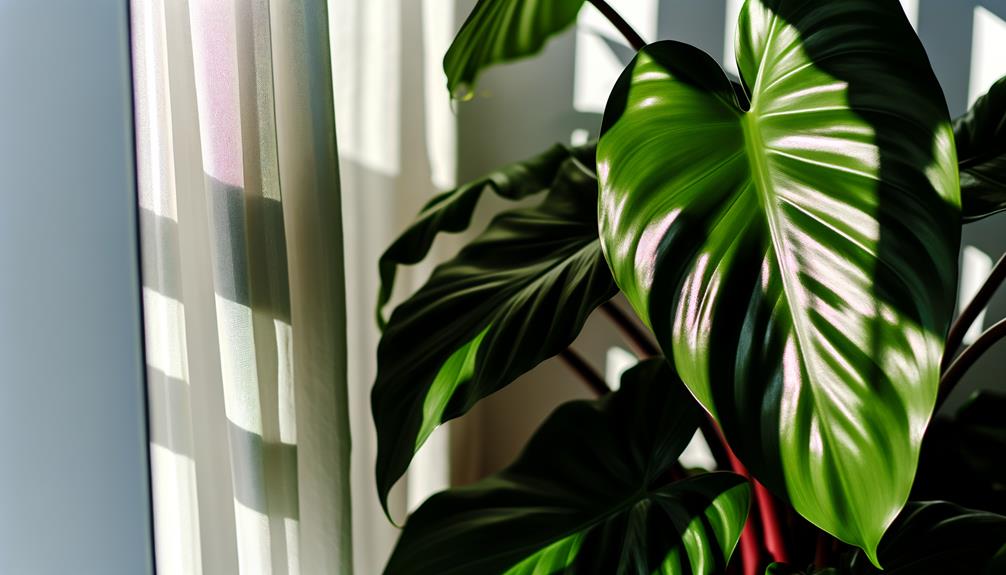
Peak growth of Philodendron Erubescens 'Ruby' requires exposure to bright, indirect light, ideally within the range of 10,000 to 20,000 lux. This specific light intensity ensures optimal photosynthetic activity, promoting vibrant foliage and robust development. Direct sunlight should be avoided to prevent leaf scorching and discoloration.
Maintain levels between 10,000 to 20,000 lux.
East or north-facing windows provide ideal indirect light.
12-14 hours of light per day is recommended.
Fluorescent or LED grow lights can supplement natural light if necessary.
Providing the correct light conditions is essential for maintaining the health and aesthetics of Philodendron Erubescens 'Ruby'.
Watering Needs
Securing sufficient hydration for Philodendron Erubescens 'Ruby' involves maintaining consistently damp soil without allowing it to become waterlogged. This typically requires watering every 7-10 days depending on environmental conditions. It is crucial to guarantee water penetrates evenly, reaching the root zone to prevent desiccation. Overwatering can lead to root rot, characterized by yellowing leaves and a foul-smelling substrate.
The ideal watering schedule should consider ambient humidity, temperature, and light exposure. A precise moisture meter can be helpful to avoid excessive soil saturation. Additionally, use tepid water to prevent thermal shock to the root system, and make sure thorough drainage is in place to mitigate standing water.
Monitoring the plant's response will help fine-tune the watering frequency.
Soil Preferences
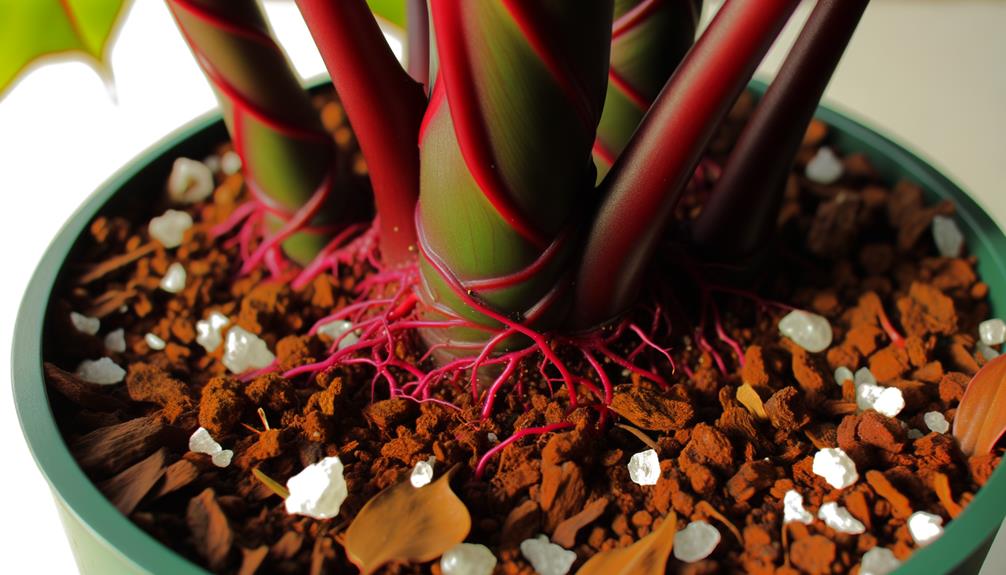
Philodendron Erubescens 'Ruby' thrives in a well-aerated, nutrient-rich soil mix with a pH range of 5.5 to 6.5, guaranteeing ideal root health and growth. To achieve prime soil conditions, consider the following components:
- Organic Matter: Incorporate 40% organic matter, such as peat moss or compost, to promote moisture retention and nutrient availability.
- Perlite: Add 20% perlite to enhance aeration and prevent soil compaction, facilitating adequate oxygenation of the root zone.
- Bark Chips: Use 20% fine bark chips to improve drainage and mimic natural forest floor conditions.
- Horticultural Charcoal: Integrate 10% horticultural charcoal to absorb impurities and maintain a balanced pH level.
These components ensure a well-draining yet moisture-retentive environment, essential for the robust growth of Philodendron Erubescens 'Ruby'.
Temperature Tolerance
In addition to its specific soil requirements, Philodendron Erubescens 'Ruby' demonstrates ideal growth within a temperature range of 65°F to 80°F (18°C to 27°C), reflecting its tropical origins. This temperature spectrum supports best physiological processes, including photosynthesis and respiration.
Exposure to temperatures below 55°F (13°C) can induce stress, manifesting as reduced growth rates or foliar damage. Conversely, prolonged periods above 85°F (29°C) may lead to dehydration and chlorosis. Maintaining a consistent temperature within the specified range is essential for the plant's metabolic functions and overall health.
Sudden temperature fluctuations should be avoided, as they can negatively impact the plant's acclimatization and adaptive capacities, potentially compromising its structural and aesthetic integrity.
Common Pests and Diseases
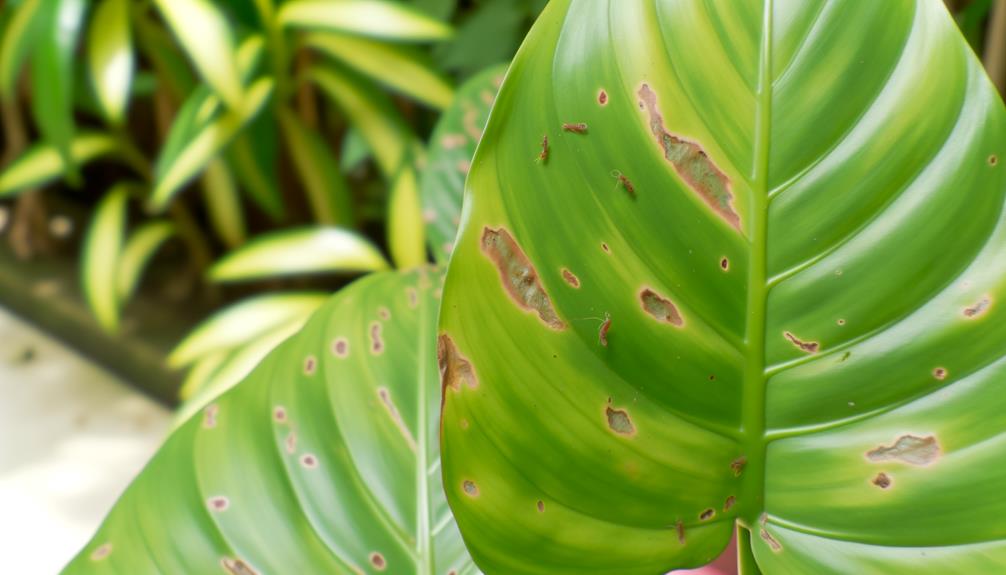
The Philodendron Erubescens 'Ruby' is vulnerable to a variety of pests and diseases, with common adversaries including spider mites, aphids, and fungal infections such as root rot. Effective management requires early identification and intervention. Key issues include:
- Spider Mites: These minuscule arachnids (Tetranychidae family) cause stippling and yellowing of leaves.
- Aphids: Small sap-sucking insects (Aphidoidea family) leading to distorted growth and sticky residue.
- Root Rot: A fungal infection (Pythium spp.) that thrives in overwatered, poorly-drained soil, causing root decay and plant wilting.
- Mealybugs: Cotton-like pests (Pseudococcidae family) that excrete honeydew, promoting sooty mold growth.
Regular monitoring and appropriate cultural practices, including adequate watering and pest control measures, are essential for maintaining plant health.
Conclusion
Philodendron erubescens 'Ruby' emerges as an alluring specimen within the botanical community, distinguished by its striking ruby-colored stems and substantial foliage. This tropical plant thrives best in indirect light, requiring consistent moisture and well-draining soil. Remarkably, it can reach a height of up to 1.5 meters under ideal conditions.
The species demonstrates a resilience to temperatures down to 13°C, though it flourishes in warmer climates. Interestingly, its expansive leaves can grow up to 30 cm in length, creating a vivid visual impact.

